Overview of Congenital Heart Disease

Nine out of every 1,000 babies born in the United States have a congenital (present at birth) heart defect - a problem that occurred as the baby's heart was developing during pregnancy, before the baby is born. Congenital heart defects are the most common birth defects.
A baby's heart begins to develop at conception, but is completely formed by eight weeks into the pregnancy. Congenital heart defects happen during this crucial first eight weeks of the baby's development. Specific steps must take place in order for the heart to form correctly. Often, congenital heart defects are a result of one of these crucial steps not happening at the right time, leaving a hole where a dividing wall should have formed, or a single blood vessel where two ought to be, for example.
The vast majority of congenital heart defects have no known cause. Mothers will often wonder if something they did during the pregnancy caused the heart problem. In most cases, nothing can be attributed to the heart defect. Some heart problems do occur more often in families, so there may be a genetic link to some heart defects. Some heart problems are likely to occur if the mother had a disease while pregnant and was taking medications, such as anti-seizure medicines. However, most of the time, there is no identifiable reason as to why the heart defect occurred.
Congenital heart problems range from simple to complex. Some heart problems can be watched by the baby's physician and managed with medicines, while others will require surgery, sometimes as soon as in the first few hours after birth. A baby may even "grow out" of some of the simpler heart problems, such as patent ductus arteriosus (PDA) or atrial septal defect (ASD), since these defects may simply close up on their own with growth. Other babies will have a combination of defects and require several operations throughout their lives.
We can classify congenital heart defects into several categories in order to better understand the problems the baby will experience. They include:
- problems that cause too much blood to pass through the lungs
These defects allow oxygen-rich blood that should be traveling to the body to re-circulate through the lungs, causing increased pressure and stress in the lungs.
- problems that cause too little blood to pass through the lungs
These defects allow blood that has not been to the lungs to pick up oxygen (and, therefore, is oxygen-poor) to travel to the body. The body does not receive enough oxygen with these heart problems, and the baby will be cyanotic, or have a blue coloring.
- problems that cause too little blood to travel to the body
These defects are a result of underdeveloped chambers of the heart or blockages in blood vessels that prevent the proper amount of blood from traveling to the body to meet its needs.
Again, in some cases there will be a combination of several heart defects, making for a more complex problem that can fall into several of these categories.
Some of the problems that cause too much blood to pass through the lungs include the following:
- patent ductus arteriosus (PDA) - this defect, which normally occurs during fetal life, short circuits the normal pulmonary vascular system and allows blood to mix between the pulmonary artery and the aorta. Prior to birth, there is an open passageway between the two blood vessels, which closes soon after birth. When it does not close, some blood returns to the lungs. Patent ductus arteriosus is often seen in premature infants.
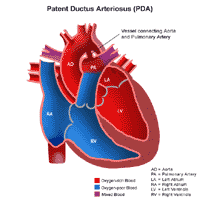 Click Image to Enlarge
Click Image to Enlarge
- atrial septal defect (ASD) - in this condition, there is an abnormal opening between the two upper chambers of the heart - the right and left atria - causing an abnormal blood flow through the heart. Some children may have no symptoms and appear healthy. However, if the ASD is large, permitting a large amount of blood to pass through the right side, symptoms will be noted.
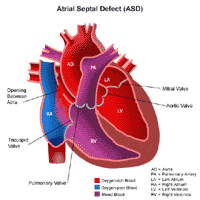 Click Image to Enlarge
Click Image to Enlarge
- ventricular septal defect (VSD) - in this condition, a hole in the ventricular septum (a dividing wall between the two lower chambers of the heart - the right and left ventricles) occurs. Because of this opening, blood from the left ventricle flows back into the right ventricle, due to higher pressure in the left ventricle. This causes an extra volume of blood to be pumped into the lungs by the right ventricle, which can create congestion in the lungs.
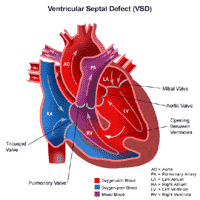 Click Image to Enlarge
Click Image to Enlarge
- atrioventricular canal (AVC or AV canal) - atrioventricular canal is a complex heart problem that involves several abnormalities of structures inside the heart, including atrial septal defect, ventricular septal defect, and improperly formed mitral and/or tricuspid valves.
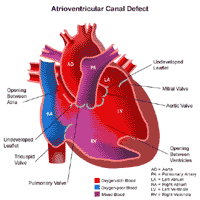 Click Image to Enlarge
Click Image to EnlargeSome of the problems that cause too little blood to pass through the lungs include the following:
 Click Image to Enlarge
Click Image to Enlarge
- pulmonary atresia (PA) - a complicated congenital defect in which there is abnormal development of the pulmonary valve. Normally, the pulmonary valve is found between the right ventricle and the pulmonary artery. It has three leaflets that function like a one-way door, allowing blood to flow forward into the pulmonary artery, but not backward into the right ventricle.
With pulmonary atresia, problems with valve development prevent the leaflets from opening, therefore, blood cannot flow forward from the right ventricle to the lungs.
- transposition of the great arteries (TGA) - with this congenital heart defect, the positions of the pulmonary artery and the aorta are reversed, thus:
- the aorta originates from the right ventricle, so most of the blood returning to the heart from the body is pumped back out without first going to the lungs.
- the pulmonary artery originates from the left ventricle, so that most of the blood returning from the lungs goes back to the lungs again
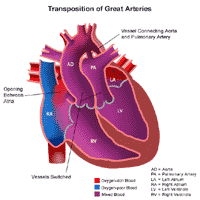 Click Image to Enlarge
Click Image to Enlarge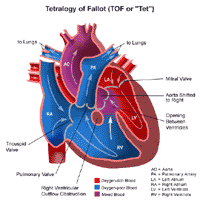 Click Image to Enlarge
Click Image to Enlarge
- double outlet right ventricle (DORV) - a congenital heart defect (one that occurs as the heart is forming during pregnancy) in which both the aorta and the pulmonary artery are connected to the right ventricle.
- truncus arteriosus - the aorta and pulmonary artery start as a single blood vessel, which eventually divides and becomes two separate arteries. Truncus arteriosus occurs when the single great vessel fails to separate completely, leaving a connection between the aorta and pulmonary artery.
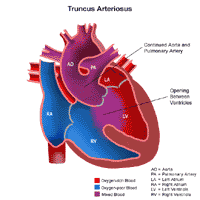 Click Image to Enlarge
Click Image to EnlargeSome of the problems that cause too little blood to travel to the body include the following:
- coarctation of the aorta (CoA) - in this condition, the aorta is narrowed or constricted, obstructing blood flow to the lower part of the body and increasing blood pressure above the constriction. Usually there are no symptoms at birth, but they can develop as early as the first week after birth. If severe symptoms of high blood pressure and congestive heart failure develop, surgery may be considered.
 Click Image to Enlarge
Click Image to Enlarge
- aortic stenosis (AS) - in this condition, the aortic valve between the left ventricle and the aorta did not form properly and is narrowed, making it difficult for the heart to pump blood to the body. A normal valve has three leaflets or cusps, but a stenotic valve may have only one cusp (unicuspid) or two cusps (bicuspid).
Although aortic stenosis may not cause symptoms, it may worsen over time, and surgery may be needed to correct the blockage - or the valve may need to be replaced with an artificial one.
 Click Image to Enlarge
Click Image to EnlargeA complex combination of heart defects known as hypoplastic left heart syndrome can also occur.
- hypoplastic left heart syndrome (HLHS) - a combination of several abnormalities of the heart and the great blood vessels. In hypoplastic left heart syndrome, most of the structures on the left side of the heart (including the left ventricle, mitral valve, aorta, and aortic valve) are small and underdeveloped. The degree of underdevelopment differs from child to child. The functional ability of the left ventricle can be reduced to the extent of not being able to pump an adequate blood volume to the body. Hypoplastic left heart syndrome can be fatal without treatment.
 Click Image to Enlarge
Click Image to EnlargeBabies with congenital heart problems are followed by specialists called pediatric cardiologists. These physicians diagnose heart defects and help manage the health of children before and after surgical repair of the heart problem. Specialists who correct heart problems in the operating room are known as pediatric cardiovascular or cardiothoracic surgeons.
Click here to view the
Online Resources of Heart Center
|